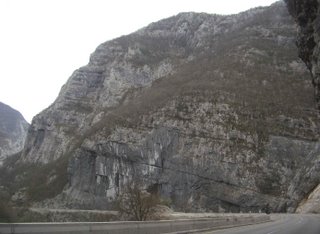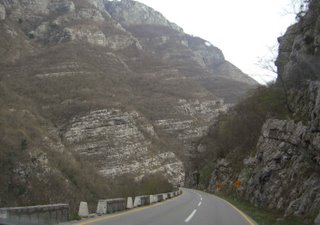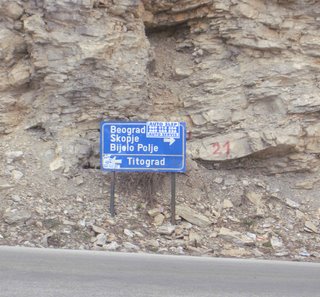More photos.... I hope you enjoy them. By the way, feel free to post a comment after any entry you read. It's the one way I have of knowing whether anyone actually looks at my blog.

This was my room at Hotel Splendid in Belgrade. I read about the hotel in a
New York Times article about Belgrade as a hip tourist spot. The article described Hotel Spendid as a budget option. It was...but I enjoyed staying there. The room was in the corner so it wasn't rectangular. The furnishing were a little worn but the sheets were clean, there was plenty of hot water, the room was warm, and the people were friendly. My room cost about $40 and I would stay there again.

People sometimes ask me, "What do you bring back from your trips?" Often there's not much to bring back. I don't go to tourist spots and some places really don't have a tourist culture yet. On my last trip home, here are things I brought: local wine and a can of beer, handmade lace, candy--yes, that's a Snicker's bar but it's a Snicker's Crunch, paprika, some Orbit mouth drops and a local competing brand of drops, and best of all....wooden spoons! This was one of the few times I've ever found wooden spoons. They were from Podgorica's green market. The wooden bowl also came from the market. They were sold as practical tools but they were a great find for me. I was sorry to see cheap, wooden spoons that were machine made in China or somewhere in Asia. How much longer will the village spoonmaker be able to continue in business? And, there were plenty of plastic items for sale also.

The terrain in Montenegro is fascinating. You see miles and miles of rocky landscape with the occassional oasis of green from a small farm or village. The farm in this photo includes several attractive buildings and the small area of green farm land, surrounded by rocky ground, covered with stunted oak trees. And, that really is one big mountain that overlooks the farm.

This is the Monestary of Ostrog, located near the city of Niksic. The monastery was built by Saint Vasilije of Zahumlje and Herzegovina, one of the four Montenegrin saints, in 1665. His body, covered by a cloth, is kept in the Monastery and people come to pray to him for health recovery or other matters of faith. I saw the remains and said a quick prayer, myself. Wall paintings in the monostary date from the 17th century. I visited here on a Saturday morning...few people had yet arrived. Inside, near many of the artifacts, were bowls with money....including one near the remains of St. Vasilije with about $700--and a watchful priest nearby. Was it the offering of that morning or from the previous days/week, or do the priests set out a little something each morning as inspiration for the faithful? I dropped in a 5E note.
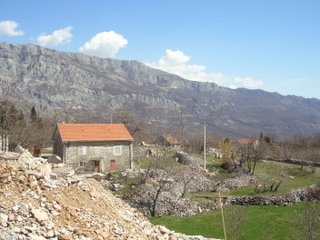
See the monostary? It's right there....on the side of the mountain. Here's a hint. Behind the house on the foreground, you can see the roof of another building. From the point of the roof, go up a little more than halfway toward the top of the mountain in the photo. That's it. Imagine being a monk and walking down the hill to the valley below to work in the fields....

If you were the monk and walked from Ortrog, you might first stop at this second monostary--a recent addition built in the 18th century--on your way to the valley below. That's it in the photo. The walk from one monostary to another, along a winding road, is about 1.5 miles. From there, you'd walk another 2 miles or so. Going down is easy enough but climbing back up would be real work...especially at the end of the day after working in the fields.
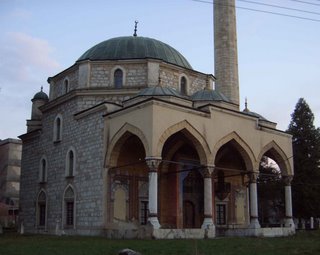
 This shot is from the balcony of my hotel room....back of the mosque...but it gives you a full look at the accompanying prayer tower. Locals, so anyway, call this The Rocket. It is a local landmark and always lets you know where you are in the city--provided you can see it.
This shot is from the balcony of my hotel room....back of the mosque...but it gives you a full look at the accompanying prayer tower. Locals, so anyway, call this The Rocket. It is a local landmark and always lets you know where you are in the city--provided you can see it. 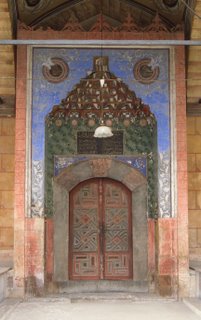 The front doors of the mosque. I probably should have snapped a close-up as well. Simply beautiful. Amazing construction and so impressive that it survived. I asked a new friend if many mosques were destroyed after the Turks left Montenegro....he said generally no and characterized the region as having religious tolerance at the time. And, even today, with 15% of the population Muslim, he described tolerance as being part of this particular area. That was an interesting statement given the killings that took place, motivated by religion and nationalism, in the 1990s. It is all part of the Balkan Paradox.
The front doors of the mosque. I probably should have snapped a close-up as well. Simply beautiful. Amazing construction and so impressive that it survived. I asked a new friend if many mosques were destroyed after the Turks left Montenegro....he said generally no and characterized the region as having religious tolerance at the time. And, even today, with 15% of the population Muslim, he described tolerance as being part of this particular area. That was an interesting statement given the killings that took place, motivated by religion and nationalism, in the 1990s. It is all part of the Balkan Paradox.
